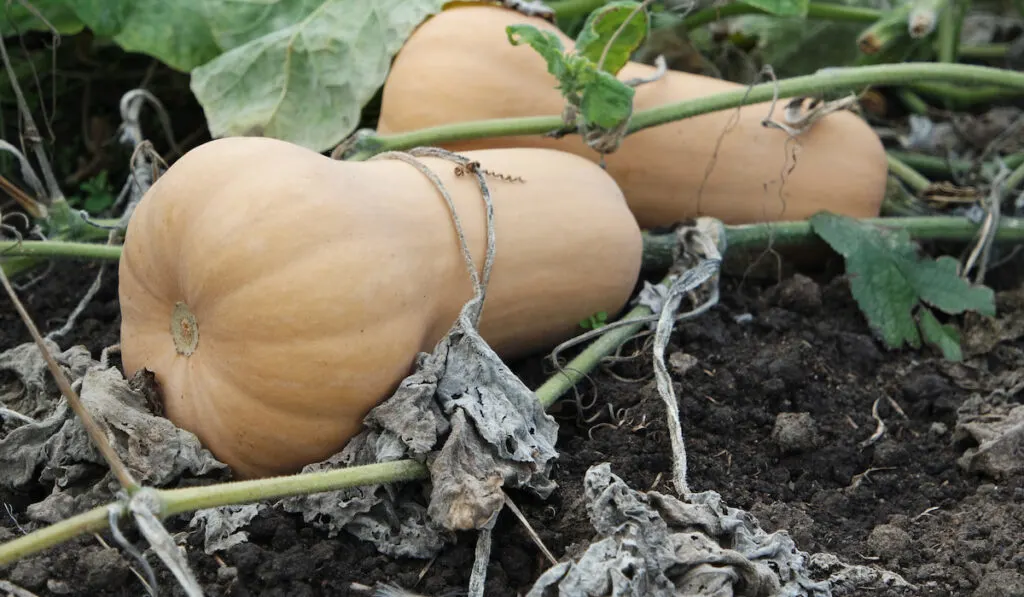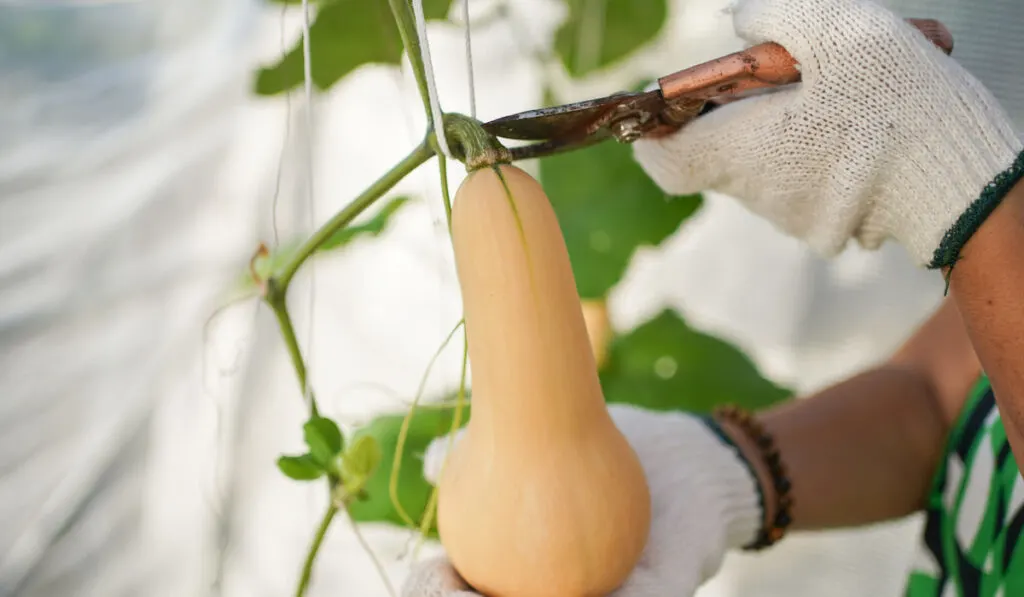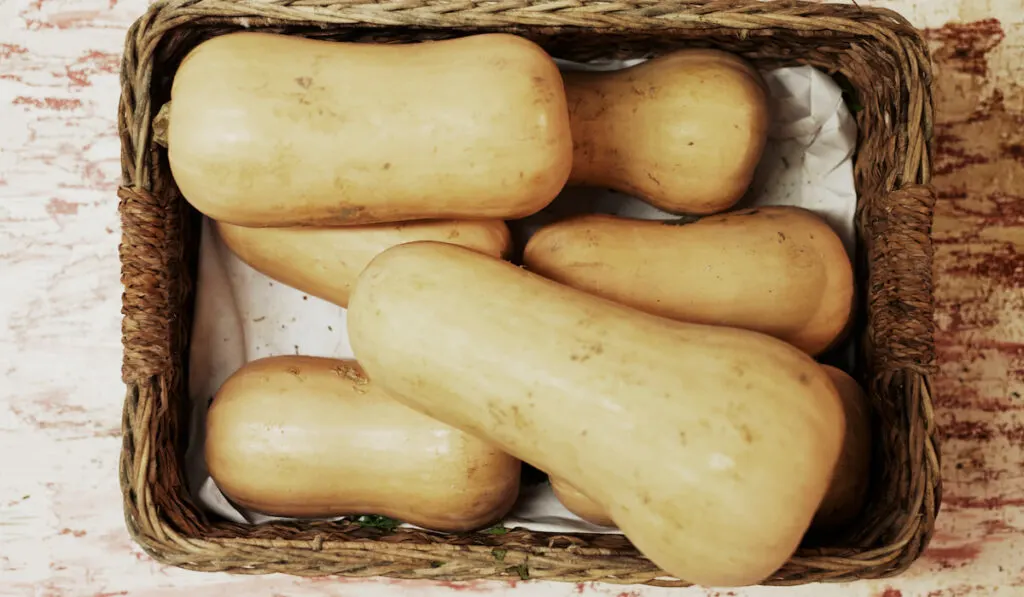Butternut squash is one of the most popular pumpkin varieties today. Its value is in its thin skin, dense pulp, and small seed area, so there is little waste after cooking preparation.
However, these are not the only advantages of butternut squash. This veggie is a treasure trove of vitamins and minerals our bodies require.
But will butternut squash ripen once picked from the vine?
With the right amount of sunlight, temperature, and humidity butternut squash will continue to ripen even after being picked from the vine.
So, if you’ve ever wondered how long it takes butternut squash to ripen or what to do with an unripe squash once it’s been picked, this article will answer all your questions.

Table of Contents
Butternut Squash in a Nutshell
Butternut squash, also known as butternut pumpkin, is an annual, vine-grown, medium-sized winter squash.
Regarding nutrition, squash is more like a vegetable than a fruit. However, butternut squash is technically a fruit because it has seeds.
Butternut squash is distinguished by its bell-like shape and yellow to slightly orange skin.
The yellow pulp has a pleasant, deep, nutty, flavor. When roasted, the vegetables take on a sweetness similar to sweet potatoes with a hint of carrot.
Due to its sweet and delicious taste, butternut squash has many potential culinary uses. While it is often used in savory meals like soups and stews, it is also delicious in sweet pastries and cakes.
Key Information:
Botanical Name: Cucurbita moschata
Common Names: Butternut squash, Butternut pumpkin, Gramma
Plant Type: Annual
Days to Harvest: 110-120
Length of a vine: 9-18 inches high and 10-15 feet wide
Hardiness Zones: 2 to 11 (UDSA)
Soil: Rich, well-draining soil with a pH range of 5.5-7.0
Light: A full sun lover
Growing needs: It grows best at temperatures between 60 and 65°F (16 and 18°C), and it needs to be fertilized regularly

When Is the Right Time to Pick Butternut Squash?
Butternut squash is best when fully ripe, so pick it as late in the season as possible to allow it to grow and mature.
But the last harvest should be done before the first fall frost so that the squash doesn’t get damaged by freezing.
Very low temperatures could make butternut squash rot or unsafe to store.
When the squash’s growth period is complete, its stems become brown, dry, and rigid. When this happens, the plant stops providing the squash with nutrients. This is a sign that your butternut squash is ready to be picked.
Ripe butternut squash might also have a hollow sound that emanates from its center. If you want to know if your squash is ripe, just knock on it.
Squash that is too young has a subtle yellow hue, while fully mature ones have tougher skin and a deeper coloration. Tap the skin of a butternut squash with your fingernail to see if it is ready to be picked. The skin of squash should be thick and tough enough to prevent puncturing.
When collecting butternut squash, check each one to ensure it is in good condition and free of any damage that could cause it to rot.
If you follow these guidelines, your squash harvest will be fruitful.
Signs your Butternut Squash is Ripe
- The stalks of butternut squash are dry and hard
- The leaves and whips on the plant are yellowed and dry
- Squash has a rich color
- Hollow sound when tapped
- The skin is hard and firm
- There should be no dents on the squash skin when pressed
- Dense pulp structure

How to Ripen Butternut Squash off the Vine
Before squash can be stored or when it needs to ripen, it needs to go through a process called “curing.”
As the squash cures, water evaporates, and its natural sugars become more concentrated. This makes the squash taste sweeter.
If your butternut squash isn’t ready, you can finish the ripening process by bringing it inside, cleaning it, and setting it in direct sunlight. The right amount of sunlight is key for squash to ripen.
Unripe butternut squash should be cured for about ten days at 80–85°F (27-29°C) and 85% humidity to speed up the ripening process.
During curing, the skin of winter squash also gets tougher. The hard skin keeps it from going bad and allows it to be stored for a long time.
Harvesting squash is a race against the coming frost for farmers. After all, bringing in some underripe butternut squash is better than losing the entire harvest to frost.
If the butternuts are post-harvest ripening, use them as soon as possible; they will not stay in good condition for as long as those that ripen on the vine.
What Happens if I Pick a Butternut Squash Too Early?
If a butternut squash is picked too soon, its pulp will lack the desired flavor and texture. Also, you won’t be able to store your butternut squash for long if they aren’t mature enough.

How to Cut Squash From the Vine
Use a sharp knife or pair of clippers at harvest time to cleanly remove the stem of your butternut squash from the vine.
Snip the stem about three to four inches from the fruit of the butternut squash and make the cut as small as possible.
You should never tear or break the stem to pick the fruit.
How Long Does It Take for Butternut Squash to Mature?
Butternut squash is an annual plant, so it needs to be planted with new seeds or seedlings every year. Each plant produces about four fruits on average.
Butternut squash is a fast-growing plant with long, thick, green shoots that can crawl along the ground or climb onto supports.
Butternut squash requires a lengthy growth season, so you should plant the seeds or seedlings in early spring. It takes three to five months to mature, and the fruits must be harvested before the first frost.
Butternut squash is vulnerable to the elements. It must be kept in a warm, sunny spot shielded from the wind, frost, and drought.
Nutrient-rich soil that drains well and retains a steady moisture level is preferable. Additionally, vegetable mineral fertilizers should be used regularly.
The ideal temperature for growth is between 60 and 65°F (16 and 18°C). When temperatures are below 50°F (10°C), it is harder for plants to get water and minerals from the soil.
4 Tips for Storing Butternut Squash
When properly stored, butternut squash has a shelf life of at least a few months; usually two to three months, but some sources suggest it can last up to six months.
So, if you follow the storage recommendations, putting in the time and effort to grow your own butternut squash is well worth it.
1. Curing Period

Squash, when harvested, must be prepared for storage. Curing is a process necessary for the lengthy storage of winter squash.
After being picked, the squash should be kept for about two weeks in a warm (80-85°F, 27-29°C), dry, and well-ventilated place.
Skin damage can cause the fruit to rot faster and reduce its storage time. Curing the fruit seals the stem after cutting and helps heal skin damage.
2. Perfect Storage Place
After the curing period, store your squash in a cool, dark place with good air circulation.
3. Keep Butternut Squash Away From Fruits
Apples, pears, and other fast-ripening fruits generate ethylene gas, accelerating butternut squash rot.
4. Keep an Eye on Your Butternut Squash When in Storage

The stock needs to be checked every few days, and any squash beginning to rot should be removed to prevent the rest from spoiling.
Final Thoughts
Let your butternut squash ripen for as long as possible to get the most flavor and healthiest fruit. Unripe squash lacks the sweetness and softness of fully mature ones.
But even if your squash does not ripen on the vine, there is a way to help it ripen. Follow the advice in this article to learn everything you need to get a tasty, ripe butternut squash.
Resources
- https://a-z-animals.com/blog/butternut-squash-vs-pumpkin/
- https://www.epicgardening.com/growing-butternut-squash/
- https://www.thespruce.com/butternut-squash-plant-5070478
- https://www.taste.com.au/healthy/articles/10-secrets-butternut-pumpkin/tz5dafo3
- https://www.epicgardening.com/how-to-store-squash/
- https://harvesttotable.com/store-winter-squash/
- https://en.wikipedia.org/wiki/Butternut_squash
- https://plantura.garden/uk/vegetables/squash/butternut-squash
- https://www.uvm.edu/news/story/tips-harvesting-pumpkins-and-winter-squash
- https://www.gardenguides.com/ripen-butternut-squash-after-picking-5797.html
- https://www.growertoday.com/will-butternut-squash-ripen-off-the-vine/
- https://homeguides.sfgate.com/ripen-butternut-squash-after-picking-78973.html
- https://www.backyard-vegetable-gardening.com/harvesting-butternut-squash.html
